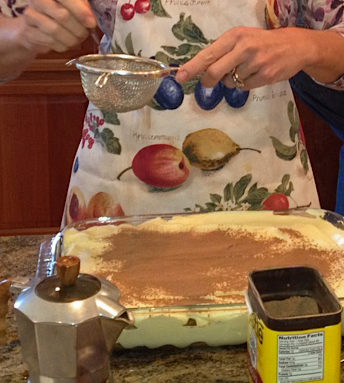In a not so ancient time, when energy drinks and protein shakes didn’t exist, Italian mothers resourced to a very simple but effective tonic: an egg yolk beaten with a tablespoon of sugar.
I can still see my mother looking worriedly at me on a winter day and pronouncing “Oh, child! Your face is the same color as a cabbage!” Then she hurried to the kitchen, to beat the egg yolk with sugar that would hopefully give me back a little energy and a healthier-looking complexion.
Our neighbor recommended adding a big dollop of mascarpone cheese to the homemade pick-me-up, as she did for her son, a six-foot-three teenager who went to his swimming practice at five-thirty every morning before school. She also confessed to saving a teaspoon of the delicious cream for her coffee.
If you are already familiar with this dessert, you must admit that the gap between my neighbor’s morning habit and Tiramisù is, indeed, quite small.
There are many different stories and theories on the origin of Tiramisù (yes, with the accent on the u) but, with these premises, I’m inclined to believe that it was indeed invented in Veneto, the northeastern region of Italy where I grew up.
I first heard of this heavenly dessert from my father, who had tried it in a restaurant near Treviso. This happened in the Seventies and, at that time, my mother couldn’t find any trace of its recipe in the family’s cookbooks – or in any other cookbook – to make it at home, nor could it be bought in bakeries.
No matter what its origins are, the person who invented Tiramisù was a culinary genius and the proof is in the speed at which this unique dessert became famous and appreciated worldwide.
Tiramisù is so rich that it can only be eaten rarely and in small portions – which is almost impossible because it’s simply irresistible.
Ingredients: A V
(for 8 people)
- 4 eggs
- 5 Tbsp. sugar
- 8 oz. (250 g.) Mascarpone cheese
- 2 cups cold espresso
- 400 g. of lady finger cookies
- 2 Tbsp. dark unsweetened cocoa powder
- 1 small pinch of salt
Leave the mascarpone cheese at room temperature for at least one hour.
Meanwhile, brew 2 cups of espresso. It must be good, strong espresso. Pour it into a shallow container, add 1 Tbsp. of sugar and let it cool down.

Separate the egg yolks from the whites, setting the whites aside to be used later.
With an electric beater, whisk the egg yolks with 4 Tbsp. of sugar until foamy and almost white. With a hand whisk, incorporate the mascarpone cheese, 1 Tbsp. at a time, mixing well to avoid any lumps.In a separate bowl, add a small pinch of salt to the egg whites and whisk them with the electric beater, until white and firm.
With a hand whisk, fold in the egg whites, adding a little at a time to the mascarpone cream with a delicate up-and-down circular movement.
Soak the ladyfingers in the espresso, one at a time and very briefly, otherwise they would break in your hands. Transfer them to a rectangular shallow glass vessel (3 to 4-inch deep) and cover the entire bottom with a layer of ladyfingers. If necessary, break the ladyfingers to fit to the bottom of the vessel. Cover with a layer of cream.
Make a second layer of soaked ladyfingers but this time layer them perpendicularly to the first layer. Think north-south for the first layer and east-west for the second. This way the portions won’t fall apart when you serve your dessert.

Cover with a second layer of cream, then put the Tiramisù in the refrigerator for at least 3 hours.
Right before serving, dust a thin layer of cocoa powder on the Tiramisu. Serve cold.

